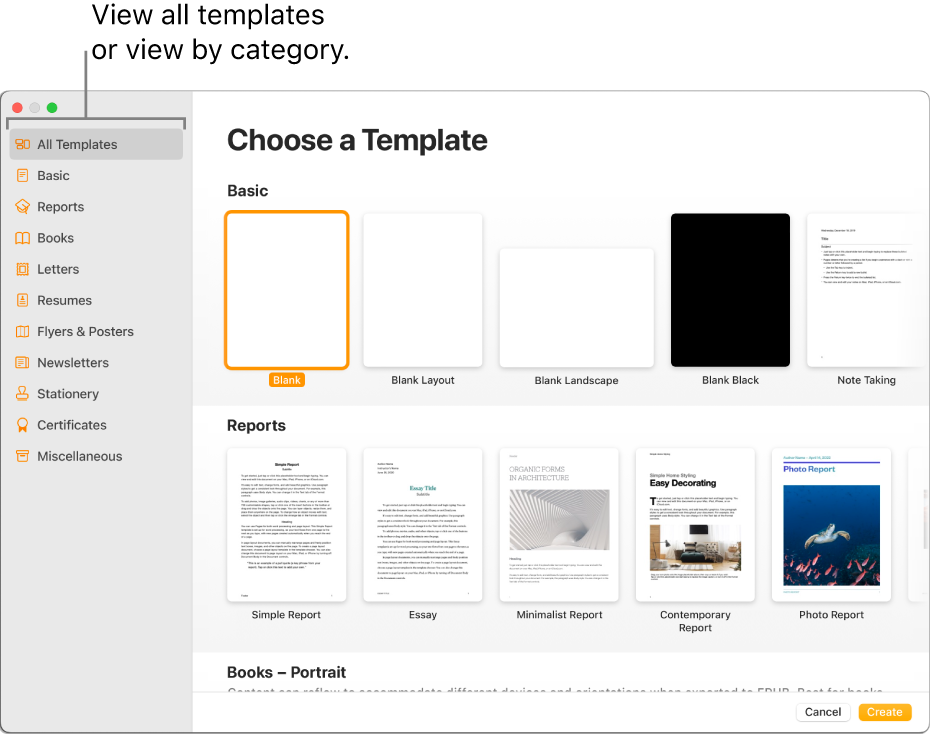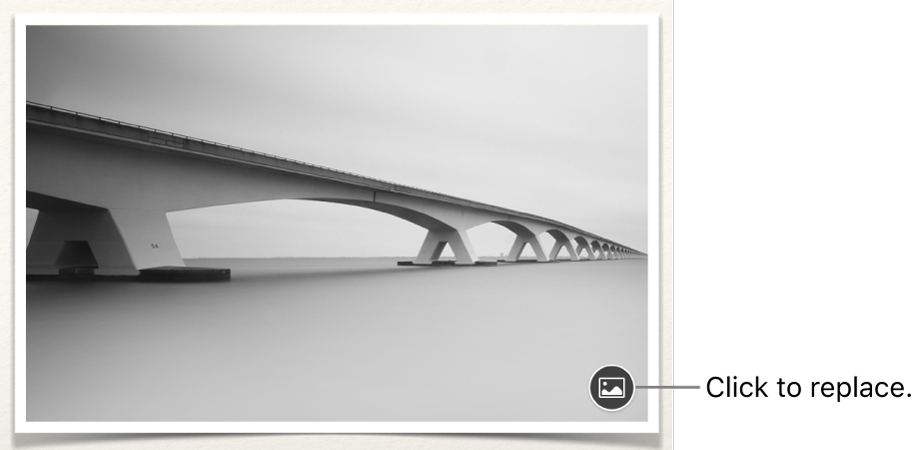
Create a document in Pages on Mac
To create a new document, you first choose a template to use as a starting point. Templates use coordinated fonts and colours for a unified look, and often include placeholder elements that you can replace with your own content.
There are two types of templates, depending on the type of document you want to create:
Word-processing: For documents that are primarily text, such as reports and letters.
Page layout: For documents with a more customised layout, such as books, posters and flyers.
To quickly create a word-processing document or a page layout document, see the first two tasks below. To see more detailed formatting and design options (including formatting for another language), see the third task.
Create a basic word-processing document
To open Pages, click the Pages icon in the Dock, Launchpad or Application folder.
If the template chooser doesn’t appear, click New Document in the bottom-left corner of the dialogue.
Double click the Blank or Blank Landscape template in the Basic category.
Start typing.
A new page is added automatically as you reach the end of the page.
Choose File > Save (from the File menu at the top of your screen), enter a name, choose a location, then click Save.
Pages automatically saves your changes as you work, so you don’t need to worry about consistently saving your document manually. However, it’s a good idea to rename your document so you can easily find it the next time you want to work on it. You can change the name of the document or change where it’s saved at any time.
If iCloud Drive is set up on your Mac, Pages saves the document to iCloud Drive by default.
To close the document, click the red close button in the top-left corner of the window.
Create a basic page layout document
To open Pages, click the Pages icon in the Dock, Launchpad or Application folder.
If the template chooser doesn’t appear, click New Document in the bottom-left corner of the dialogue.
Double click the Blank Layout template in the Basic category.
Click Text
 in the toolbar to add a text box, then start typing.
in the toolbar to add a text box, then start typing.Do any of the following to adjust the text box:
Move it: Click outside the text box to unselect the text, then drag the text box anywhere on the page.
Resize it: Click outside the text box to unselect the text, then click the text box to show the square resize handles. Drag a handle on the top, bottom or sides to resize the text box horizontally or vertically, or drag a corner handle to resize it proportionally. If a clipping indicator
 appears at the bottom, drag it until all of the text is visible.
appears at the bottom, drag it until all of the text is visible.
Choose File > Save (from the File menu at the top of your screen), enter a name, choose a location, then click Save.
Pages automatically saves your changes as you work, so you don’t need to worry about consistently saving your document manually. However, it’s a good idea to rename your document so you can easily find it the next time you want to work on it. You can change the name of the document or change where it’s saved at any time.
If iCloud Drive is set up on your Mac, Pages saves the document to iCloud Drive by default.
To close the document, click the red close button in the top-left corner of the window.
Create and format a document
To open Pages, click the Pages icon in the Dock, Launchpad or Applications folder.
If the template chooser (shown below) doesn’t appear, click New Document in the bottom-left corner of the dialogue. You can also hold down the Option key and choose File > New (from the File menu at the top of your screen).

In the template chooser, browse templates by category or click All Templates, then double click a template to open it.
To see whether the template is designed for word processing or page layout, click
 in the toolbar. If there’s a Bookmarks tab at the top of the sidebar, it’s a word-processing document. If not, it’s a page layout document.
in the toolbar. If there’s a Bookmarks tab at the top of the sidebar, it’s a word-processing document. If not, it’s a page layout document.Do any of the following:
Add or edit text: In a word-processing document, just begin typing. The blinking insertion point indicates where your text starts. In a page layout document, add a text box (see below), then type. To edit text, select the text, then type. To format the selected text, use the controls in the Format
 sidebar on the right.
sidebar on the right.Replace place holder text: Click the place holder text, then type your own. Some templates include placeholder text written in lorem ipsum (scrambled Latin), but the text you type to replace it appears in the language you use.
Add new text boxes, images, shapes or other objects: Click an object button in the toolbar.

Replace place holder images: Click
 in the lower-right corner of a placeholder image to choose an image on your computer, or drag an image from your Mac or a web page to a placeholder image.
in the lower-right corner of a placeholder image to choose an image on your computer, or drag an image from your Mac or a web page to a placeholder image.
Add a page: In a word processing document, a new page is automatically added as your typing reaches the end of a page. In a page layout document, you need to add a blank page manually — click the page that you want the new page to follow, then click the Add Page
 button in the toolbar. (You can also use this method to manually add a page to a word-processing document.) See Add pages in Pages on Mac.
button in the toolbar. (You can also use this method to manually add a page to a word-processing document.) See Add pages in Pages on Mac.Undo or redo recent changes: Choose Edit > Undo or Edit > Redo (from the Edit menu at the top of your screen).
Choose File > Save (from the File menu at the top of your screen), enter a name, choose a location, then click Save.
Pages automatically saves your changes as you work, so you don’t need to worry about consistently saving your document manually. However, it’s a good idea to rename your document so you can easily find it the next time you want to work on it. You can change the name of the document or change where it’s saved at any time.
If iCloud Drive is set up on your Mac, Pages saves the document to iCloud Drive by default.
To close the document, click the red close button in the top-left corner of the window.
